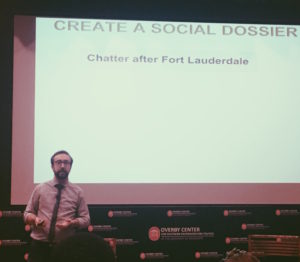
Victor details uses of social media
David Victor, senior staff editor for New York Times, presented to an audience of over 60 attendees the different ways reporters can use social media to enhance their storytelling.
In an hour and 27-minute presentation at the 31st SEJC Convention at the University of Mississippi, Victor revealed a variety of social media tips to young journalists on such networks as Twitter and Facebook, as well as third-party aids to these networks, like CrowdTangle and Tweetdeck.
“I think a lot of times when we think about social media, we think about putting our stories out there,” he said. “You know, trying to get traffic from them or you think about horrible people harassing you. Yes that stuff exists, but I want to get past that and talk about the ways we can use it for good.”
Victor discussed how to search Twitter for story ideas and sources, how to monitor social media and how to find contact sources through social media and building Twitter lists.
Victor told a story of Michael Paulson, a religion reporter for the Times, who was working on an assignment centered around Orthodox Jews and members of other religions, who refuse to sit next to women on planes because it’s against their religion. In the story, he noted that you can’t go to an airline and say, “Excuse me; can you connect me to your most disgruntled passengers?”
Without having to go to airlines or ask random people about Orthodox Jews, Victor assisted Paulson in his research for sources and performed what he called “perfect source tweeting”— searching Twitter for keywords a person might use in a situation with an Orthodox Jew or in any other situation.
“The overall rule here is to think what your perfect source would tweet,” he said. “Imagine you are in the situation, think about what you would say.”
Through perfect source tweeting, Paulson and Victor were able to do eight interviews from Twitter and five were used in the story. Victor said when searching these tweets, think of keywords a person would use. He said the most common words to look for are “I,” “me” and “my.” Keywords used for Paulson’s story were “Jew,” “flight” and “plane.”
For a train crash that Victor covered, he searched for tweets reading, “I’m safe” and “I’m alive.”
He also stressed the importance of being aware of fake sources and how to verify if the source is telling the truth.
“Every time there is a mass shooting in this country, there are people who will fake tweets saying, ‘Oh my God, I was in that building. I’m so glad I got out,’” he said. “No idea why they decide to do this, but every single time, there are news organizations that seem to fall for it.”
Victor also taught the audience how to build a social dossier, which is a method used by The New York Times to identify people through their social media who may be named in breaking news.
In this interactive part of the session, Victor showed the audience his personal Facebook and asked the audience to point out ways to identify if he was real.
“Maybe look on the New York Times website to see if you actually have the position that you say you have,” an audience member said to Victor.
Searching through people’s profiles and viewing whom they are connected to provides good opportunities to find information on someone and to ask more personalized questions and verifying a source, according to Victor.
The social media tool Victor appeared to be the most passionate about, and whose use he encouraged, was Twitter lists. A Twitter list is a curated group of Twitter accounts that a user can personalize for his or her own profile. A user can also subscribe to lists created made by other users.
“If you have local TV stations, local newspapers that you’re competing against, student blogs, whatever that might be, you can put them all in a feed,” he explained. “You could create a list of college newspapers from across the country and maybe see which of their posts are doing really well and you might be able to localize the idea.”
To help with lists, Victor recommended the use of CrowdTangle, a third-party website that helps keep better track of your lists.
Also, Victor discussed how to talk to a source online for a potential quote or how to find general information you’re using in your story.
“Be specific about what you want and keep your requests simple,” he said.
Victor has worked for the Times for four years. Previously, he had served as the social media editor for ProPublica Inc. He graduated from Penn State University with a degree in journalism and is originally from Boalsburg, Pennsylvania.
